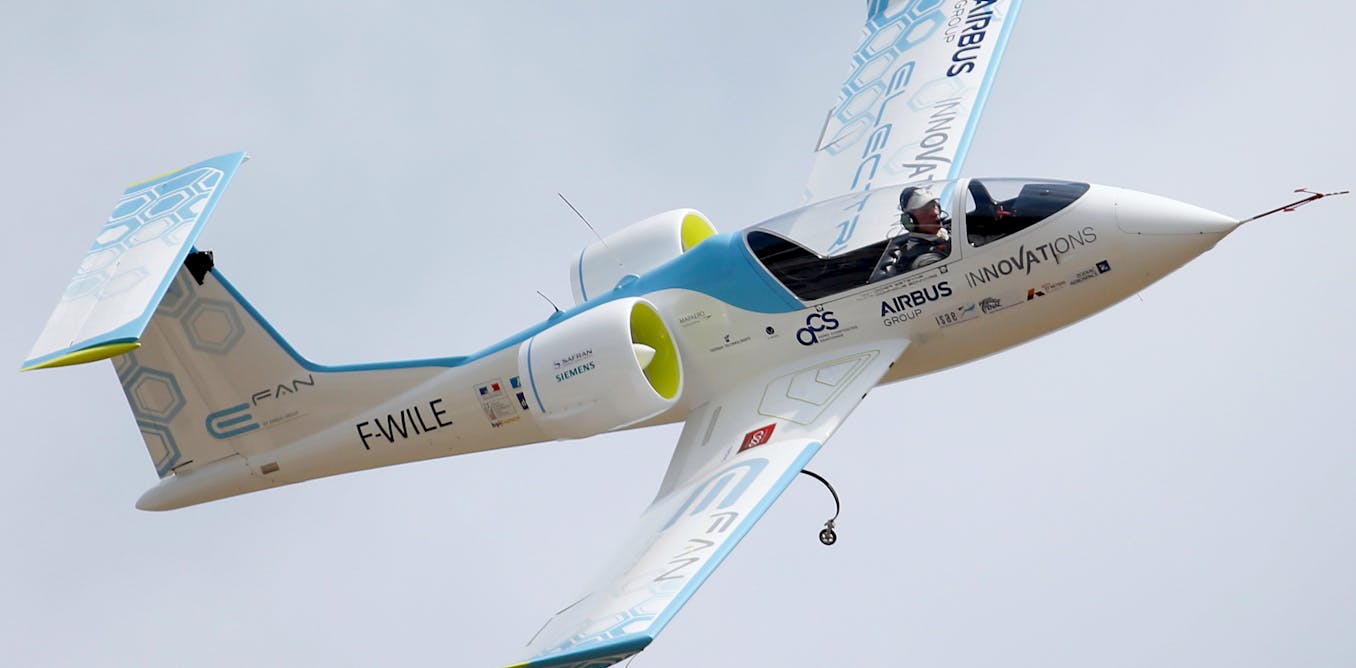
Electric aircraft – the future of aviation or just wishful thinking?
- Select a language for the TTS:
- UK English Female
- UK English Male
- US English Female
- US English Male
- Australian Female
- Australian Male
- Language selected: (auto detect) - EN
Play all audios:

Since the dawn of aviation, planes have primarily been powered by carbon-based fuels such as gasoline or kerosene. These contain a lot of energy for their weight, providing the vast power
required to lift large commercial airliners on journeys across the globe. But with oil resources declining and penalties on greenhouse gas emissions increasing, the future of aviation is
dependent on finding an alternative power source. Is electricity the answer? A first step is to develop “more electric aircraft” – jet-powered planes that maximise the use of electricity for
all the other aircraft systems. The idea is to significantly reduce fuel consumption by improving overall energy efficiency. In practice, this means reducing the weight of the aircraft,
reducing drag with improved aerodynamics and optimising the flight profile to use less fuel. But though these improvements can save on fuel, that alone isn’t enough. The shift to more
sustainable aircraft requires major, longer-term solutions. Such significant innovations have often been driven by military requirements. The jet turbine engine was developed during World
War II and the US Air Force’s Chuck Yaeger first broke the sound barrier in the Bell X-1 as part of the Cold War race to achieve supersonic speeds. The drive for new technologies led to
massive improvements in performance and reliability, which has since filtered through to commercial aviation and made mass intercontinental air travel a reality. Concorde was the ultimate
expression of this transformation from military to high-performance commercial aircraft, but despite its phenomenal performance it was plagued by complaints of excessive noise and pollution.
Modern jet air travel still consistently raises such environmental concerns and, while the military has an obvious incentive to design the fastest aircraft, its motivation to go green is
less obvious. We may need to look elsewhere for the next big innovation. CLEANING UP THE SKIES? Solar-powered endurance aircraft have received a lot of attention recently, with the Solar
Impulse team attempting to make the first round-the-world flight. But solar power, while an interesting technical challenge, is not a particularly realistic option for mass transit of
passengers. As can be seen from the Solar Impulse aircraft, the power output from the Solar Panels on a very wide wingspan is able to transport only the aircraft and the pilot for any
significant distance. Battery storage is the key limiting factor for electric aircraft. If electric aircraft are held back by either weight or fuel restrictions, it’s probably down to the
battery. Aircraft typically have a longer fuelling time than a car, so rapid recharging is possible and effective, as current jet aircraft take about the same time to refuel (and also for
passenger and cargo turnaround) so electric charging of about 1hr is reasonable, however the critical problem is energy density – how much energy does the battery provide for its weight?
Typical lithium-ion batteries in use today have a maximum energy density of around 1,000,000 joules of energy per kilogram, and while newer research promises the possibility of higher
densities, these are not available commercially. A million joules sounds like a lot. However, compare this with 43 million joules per kilogram for aviation fuel. Swapping the fuel tanks for
a battery weighing 43 times as much isn’t a viable option – clearly there’s a significant storage problem to be solved before electricity can power large aircraft over long distances. THE
FUTURE FOR ELECTRIC AIR TRAVEL So where does electric power fit in the long-term vision for consumer air travel? Despite the obvious technical challenges, The Airbus prototype E-Fan aircraft
is due to be put into production by 2017. The E-fan is a very light two-seater plane powered by two electric motors, with a relative speed and carrying capacity far lower than those
required by commercial carriers. However, Within the next decade, this technology may extend to short-range commuter and business aircraft – especially targeting routes that still use
conventional propeller propulsion. Airbus has medium-term plans for such an aircraft, with a target capacity of perhaps 60 passengers – making it a suitable platform for short-haul commuter
flights. Safety and reliability must be addressed before electric aircraft are adopted by commercial airlines. Much as the electric car still has to achieve a critical level of public
confidence, perceived reliability will have a significant impact on consumer trust in new aircraft. If prototypes such as the E-Fan can build public confidence, this may mark a “tipping
point” in overcoming the technical challenges inherent in any new form of transportation, especially in aviation which has a track record of rapid innovation. Advances – particularly in new
materials, storage and power electronics technology – may offer the prospect of purely electric commercial aircraft within the next two decades.
